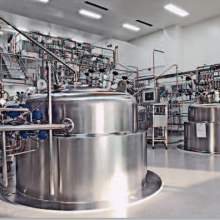Description
Microorganisms are used in large-scale plants for the commercial production of products such as yeast. The age structure of the population of microorganisms is particularly relevant for the amount of product that can be obtained. The most realistic laboratory setup to reproduce nature and thus observe population dynamics is the chemostat reactor.
The reactor contains biomass, i.e. microorganisms and nutrient solution. The second one is pumped through a tube both into and out of the reactor. This keeps the volume constant. The circulation reflects the continuous turnover of nutrients in nature. Normally, the metabolism of the substrate would cause the living conditions in the reactor to change. However, these are kept constant by subordinate control loops so that the only variable affecting population growth is the concentration of the substrate in the reactor. This is adjusted by the pump current, which is proportional to the dilution rate.
Partial differential equations are used to mathematically describe the age structure of the population.
The aim of the project is to develop an input/output model and to design controls based on it. In addition, Pontryagin's maximum principle is used to calculate optimal controls.
Funding
The project is funded by the DFG.



